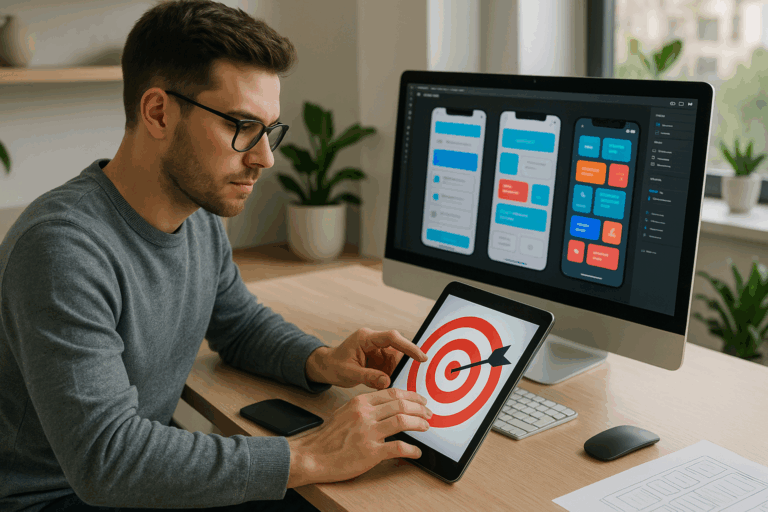At the forefront of this paradigm, Alt Text serves as a cornerstone, championing inclusivity while simultaneously boosting search engine optimization (SEO). 💪
This might seem like a lot to digest, but fear not! This comprehensive guide is here to dissect and decode the underlying mechanisms of Alt Text, illustrating its power and potential in an easily comprehendible manner. 📘
Whether you’re a seasoned web developer, an SEO specialist, or just a curious reader aiming to improve your digital literacy, this blog post is tailored to demystify the concept of Alt Text, its relevance, and how it can be harnessed to enhance accessibility and optimize SEO.
🎯 Focus of this Guide
Our journey will commence by understanding the fundamentals – what exactly is Alt Text? This exploration will unravel the essence of Alt Text and its role in providing a more inclusive and accessible web experience. We will delve into the intricate workings of this powerful tool, spotlighting its significance in the realm of accessibility. 🌐
Next, we’ll shift gears and delve into the interconnection between Alt Text and SEO. It might come as a surprise to learn that this hidden attribute of an image not only amplifies the inclusivity of your content, but also plays a pivotal role in enhancing your website’s visibility on search engines. 🚀
In the latter section of our guide, we’ll learn how to craft effective and descriptive Alt Text. Unraveling the art of writing efficient Alt Text, we will explore techniques and guidelines that can be employed to create meaningful descriptions. An art more than a science, crafting Alt Text requires a balance between precision, conciseness, and creativity. ✍️
Finally, we’ll round off our discussion with some real-life examples and case studies, highlighting how effective utilization of Alt Text can create a seismic shift in both accessibility and SEO. The proof, as they say, is in the pudding! 🍮
🚀 Embark on the Journey
By journey’s end, you will be equipped with the knowledge to unlock the true power of Alt Text, and harness its potential to improve the accessibility of your digital content and supercharge your SEO strategy. This voyage of discovery promises to be as enlightening as it is empowering. So, buckle up and let’s unlock the power of Alt Text together!
As we embark on this journey, remember, the true power of Alt Text lies not just in its technical functionality, but in its capacity to foster inclusivity, enhance user experience, and ultimately, democratize the digital world. 🌍
So, are you ready to unlock the power of Alt Text, enhance accessibility, and boost SEO with descriptive image descriptions? Let’s get started!
Unlocking the Power of Alt Text: Enhance Accessibility and Boost SEO with Descriptive Image Descriptions
Today, we delve into the fascinating world of alt text. This powerful SEO tool serves a dual purpose: enhancing website accessibility and boosting your site’s SEO ranking. However, it’s often overlooked or misunderstood. Therefore, this comprehensive guide aims to shed light on its potential. Let’s dive in!
Understanding the Essence of Alt Text
Alt text, also known as alternative text or alt tags, is the text description added to an image’s HTML code on a web page. It’s visible to search engine crawlers and screen readers, providing a textual context for non-textual content, i.e., images. So, why does alt text matter? Let’s consider its twin benefits:
Enhancing Web Accessibility
Alt text fundamentally transforms the web experience for visually impaired users. Screen readers read out the alt text, allowing visually impaired people to understand the image content. Therefore, alt text creates an inclusive web environment, a fact increasingly recognized by legal frameworks, such as the Americans with Disabilities Act (ADA).
Boosting SEO
Alt text is also crucial for search engine optimization. Search engine crawlers rely on alt text to understand image content, directly impacting your website’s SEO ranking. A well-optimized image can increase your site’s visibility on image search results, attracting more organic traffic.
Alt Text Best Practices
Knowing the benefits of alt text, you might be tempted to go on an alt text frenzy. But wait! To harness the power of alt text effectively, you need to understand its best practices:
Be Descriptive
Your alt text should accurately and succinctly describe the image. Avoid vague descriptions like “image” or “icon” and instead detail the image’s content and purpose. For instance, alt text for a signup button could be “signup button for our monthly newsletter.”
Keep It Concise
While you need to be descriptive, it’s also crucial to be concise. Screen readers typically cut off alt text at around 125 characters, so try to keep your descriptions within this limit. Moreover, lengthy alt text may be perceived as keyword stuffing by search engine crawlers, which could negatively impact your SEO ranking.
Use Keywords Judiciously
While alt text contributes to SEO, it’s not a place for keyword stuffing. Use your targeted keywords in your alt text only if they naturally fit the image’s description. Forced or unnecessary use of keywords can lead to penalties from search engines.
Alt Text Vs. Title Text: What’s the Difference?
People often confuse alt text with title text, but these two HTML attributes serve different purposes:
| Alt Text | Title Text |
|---|---|
| Describes the image content for screen readers and search engine crawlers. | Provides additional information about the image when the mouse hovers over it. |
In essence, alt text prioritizes accessibility and SEO, while title text enhances user experience by providing additional (non-essential) information.
Implementing Alt Text in Your Web Content
Implementing alt text might seem technical, but it’s relatively straightforward. Most content management systems (CMS) offer simple ways to add alt text to images. For instance, in WordPress, you can add alt text in the “Alt Text” field when uploading an image.
Here’s a practical example:
- HTML code without alt text:
<img src="dog.jpg"> - HTML code with alt text:
<img src="dog.jpg" alt="A brown dog playing in a park">
As seen in the examples, the alt text “A brown dog playing in a park” gives a clear description of the image content, making it accessible and SEO-friendly.
The Impact of Alt Text on SEO and Accessibility: Real-World Examples
Let’s bring the power of alt text to life with some real-world examples. Consider two scenarios: a home décor website and a news platform.
Home Décor Website
Without alt text, a visually impaired user relying on a screen reader wouldn’t know what the images depict, significantly hampering their shopping experience. Moreover, without alt text, search engine crawlers can’t index the images, causing the site to lose potential organic traffic from image searches.
News Platform
For a news website with numerous images accompanying articles, lacking alt text can exclude visually impaired readers from fully understanding the content. Also, the platform might miss out on visibility in image search results, impacting its SEO ranking and traffic.
For a detailed explanation on how to implement alt text effectively, watch “How To Add Alt Text To Images For SEO” by WPBeginner – WordPress Tutorials on YouTube.
Embrace the Power of Alt Text
In a world where visual content reigns, alt text is a potent tool to enhance web accessibility and boost SEO. By understanding and applying alt text best practices, you can create a more inclusive and visible web presence. Remember: each image is an opportunity. So, seize them all and unlock the power of alt text!
Further Learning Resources
For those interested in further exploring alt text and other SEO strategies, I highly recommend the following resources:
- Google’s SEO Starter Guide: A comprehensive guide from the search engine giant itself.
- Moz’s Beginner’s Guide to SEO: An excellent resource covering all basics of SEO.
- Yoast’s Definitive Guide To Alt Tags: A detailed guide specifically focused on alt text.
And that’s it! Continue your journey in SEO and accessibility, and remember: the power of alt text is at your fingertips. Harness it to create a more accessible and visible web presence.

Conclusion
In conclusion, this comprehensive discourse on advanced topics in Information Technology (IT) and Engineering has navigated through a vast spectrum of themes, diligently explaining complex concepts in an understandable and relatable manner. The objective was to transcend the jargon and technicality often associated with these fields and make the content accessible for all levels of expertise.
To recapitulate, we began with a deep dive into modern IT paradigms, exploring the nuances of Cloud Computing, Big Data, and Artificial Intelligence. The aim was to unpack these buzzwords and shed light on their practical applications in the real world. We delved into the architecture, pros, cons, use-cases, and the future trends in these domains. We then transitioned into Engineering, where we scrutinized essential concepts like Systems Engineering, Software Engineering, and Material Engineering, emphasizing their roles in shaping our current technological landscape.
We touched on the significance of Cybersecurity, underscoring its paramountcy in protecting sensitive data and maintaining the integrity of IT systems. Additionally, we explored the burgeoning field of Quantum Computing, discussing its potential in revolutionizing the future of computing. Finally, we ended with an informative piece on Blockchain technology, dissecting its structure, functionality, and prospective applications.
Revisiting these topics is essential, not only to consolidate our understanding but also to appreciate the far-reaching implications they hold for our society. The discussions attempted to paint a comprehensive picture, encouraging readers to delve deeper into these subjects, fostering a culture of continuous learning.
We can all agree that the importance of these topics cannot be overstated. The advancements in IT and Engineering are instrumental in shaping the world as we know it, and staying informed about these developments is more crucial than ever. The dialogue doesn’t end here. In fact, this is just the beginning. We invite you to join the conversation, share your insights, and even challenge the ideas presented.
We welcome your comments and encourage you to share the article with your peers. After all, knowledge is best when shared. To continue this journey of learning, you may find the following resources helpful:
– IBM on Cloud Computing
– Oracle on Big Data
– Intel on Artificial Intelligence
– Britannica on Systems Engineering
– CSO Online on Cybersecurity
– IBM on Quantum Computing
– Investopedia on Blockchain
Remember, the goal is not to become experts overnight, but to develop an informed perspective and nurture our curiosity. The world of IT and Engineering is vast and fascinating, full of challenges and opportunities. As we delve deeper into these subjects, we begin to unravel the complexities, revealing a world that is not only technologically advanced but also profoundly human.
Until next time, keep exploring, keep learning, and stay inspired! 😊🚀🌐



